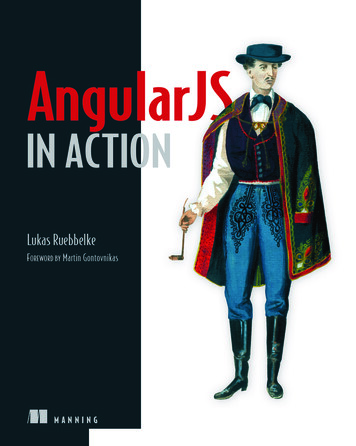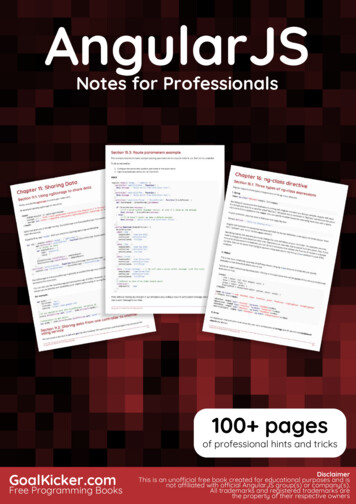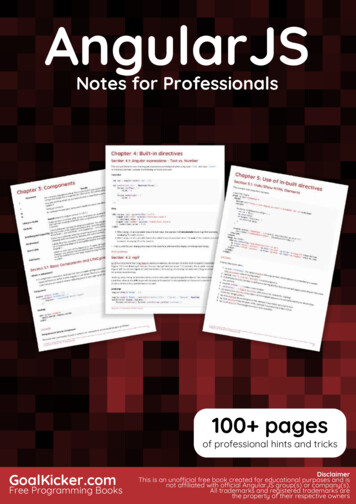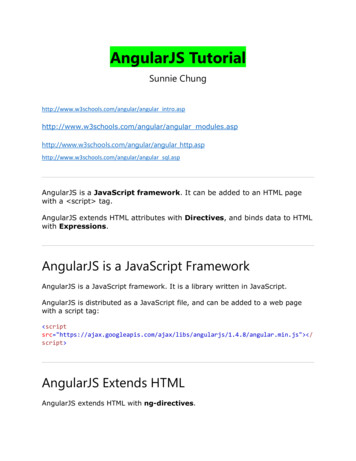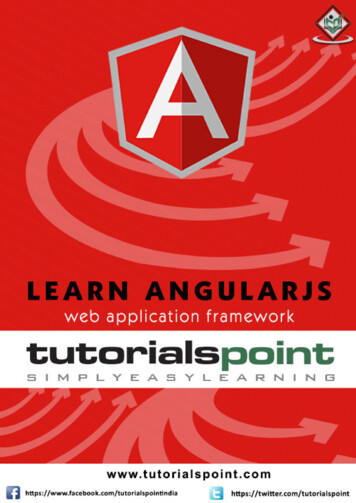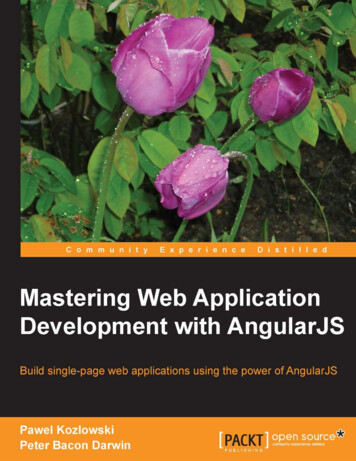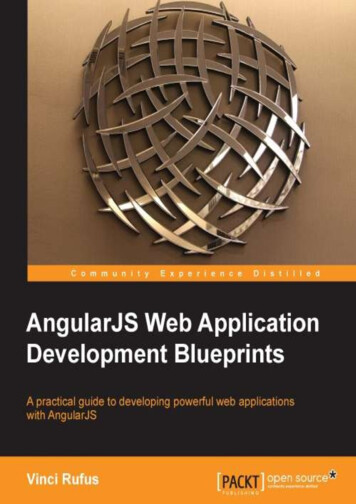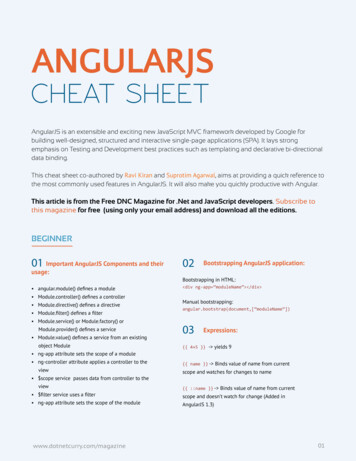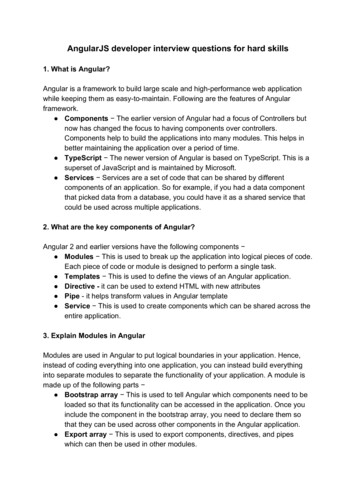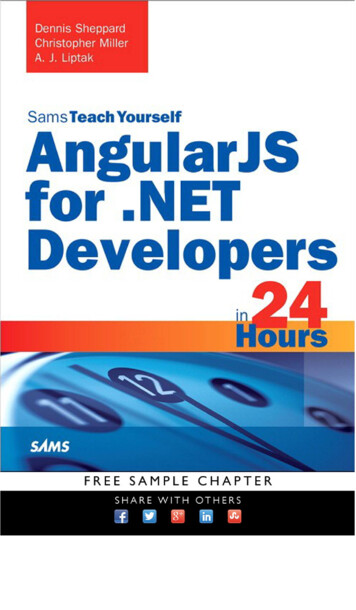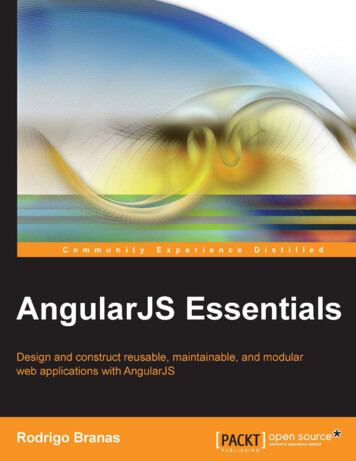
Transcription
AngularJS EssentialsDesign and construct reusable, maintainable, andmodular web applications with AngularJSRodrigo BranasBIRMINGHAM - MUMBAI
AngularJS EssentialsCopyright 2014 Packt PublishingAll rights reserved. No part of this book may be reproduced, stored in a retrievalsystem, or transmitted in any form or by any means, without the prior writtenpermission of the publisher, except in the case of brief quotations embedded incritical articles or reviews.Every effort has been made in the preparation of this book to ensure the accuracyof the information presented. However, the information contained in this book issold without warranty, either express or implied. Neither the author, nor PacktPublishing, and its dealers and distributors will be held liable for any damagescaused or alleged to be caused directly or indirectly by this book.Packt Publishing has endeavored to provide trademark information about all of thecompanies and products mentioned in this book by the appropriate use of capitals.However, Packt Publishing cannot guarantee the accuracy of this information.First published: August 2014Production reference: 1140814Published by Packt Publishing Ltd.Livery Place35 Livery StreetBirmingham B3 2PB, UK.ISBN 978-1-78398-008-6www.packtpub.com
CreditsAuthorRodrigo BranasReviewersProject CoordinatorAboli AmbardekarProofreadersAndrei M. EichlerSimran BhogalCleberson C. C. FaccinMaria GouldRuoyu SunAmeesha GreenFelipe TrevisolPaul HindleCommissioning EditorPramila BalanIndexersMariammal ChettiyarRekha NairAcquisition EditorHarsha BharwaniContent Development EditorSharvari TawdeTechnical EditorsShiny PoojaryKirti PujariAkash Rajiv SharmaPriya SubramaniGraphicsRonak DhruvDisha HariaProduction CoordinatorAlwin RoyCover WorkAlwin RoyCopy EditorsRoshni BanerjeeMradula HegdeAlfida PaivaCover ImageYuvraj Mannari
About the AuthorRodrigo Branas is a software architect, author, and international speaker onsoftware development based in Brazil, with more than 12 years of experience indeveloping enterprise applications.Lately, he has been participating in the development of many successful productsbased on the AngularJS framework. A major part of these applications were madeavailable to the education industry, and are now used by thousands of users acrossthe country.He is also the founder of Agile Code, a consultancy and training company that workseffectively with architects, developers, designers, and testers in order to producehigh-quality products.He graduated in Computer Science and has an MBA degree in Project Management.He is certified in SCJA, SCJP, SCJD, SCWCD, and SCBCD from Sun Microsystems;PMP from Project Management Institute; MCP from Microsoft; and CSM fromScrum Alliance.In the past few years, he has dedicated himself to spreading knowledge in thesoftware development community. Also, he is the author of Java Magazine, one of themost recognized technical publications in Brazil. His website address is http://www.agilecode.com.br. He can be contacted at rodrigo.branas@gmail.com and youcan follow him on Twitter at @rodrigobranas.
AcknowledgmentsWriting this book was an incredible challenge! Throughout this time, I had thepleasure to count on my lovely wife, Rosana Branas, who provided me with all theinspiration, motivation, and affection that I needed.Also, I am very happy and glad about sharing this experience with my reviewers:Felipe Trevisol, Cleberson Faccin, Andrei Eichler, and Ruoyu Sun. They provided mewith their views, which I feel were quite important, and advice that helped improvethe text considerably.I also would like to thank my great friend, Rafael Nami, who introduced me to theAngularJS world, helping me during my first steps with this amazing technology.Special thanks to the outstanding editorial team at Packt Publishing: Ankita Goenka,Aboli Ambardekar, Harsha Bharwani, Sharvari Tawde, Shiny Poojary, Kirti Pujari,and Veena Manjrekar.Finally, this book would not be complete without the support of my family! I wouldespecially like to thank my mom and dad, for the continuous love, education,support, and encouragement that they have always provided me!
About the ReviewersAndrei M. Eichler is a young developer with a great passion for learning. Hismain experiences include working with large Postgres databases and Java, and he isnow venturing into Scala, performant JavaScript, and web application development.Cleberson C. C. Faccin is a graduate in Systems Information from UniversidadeFederal de Santa Catarina, Brazil. Since 2004, he has been working in the fieldof software development. During these 10 years, he has worked with severaltechnologies, from mainframes to applications of mobile devices. Currently, hisfocus is on his work in JavaScript, where he is building applications for mobileswith JavaScript.Ruoyu Sun is a designer and developer living in Hong Kong. He is passionateabout programming and has contributed to several open source projects. He is thefounder of several tech start-ups using a variety of technologies before working inthe industry. He is the author of Designing for XOOPS, O'Reilly Media.I would like to thank all my friends and family who have alwayssupported me.Felipe Trevisol is a software architect who loves research, travel, and playingguitar. He has worked with SOA and systems integration.
www.PacktPub.comSupport files, eBooks, discount offers,and moreYou might want to visit www.PacktPub.com for support files and downloads related toyour book.Did you know that Packt offers eBook versions of every book published, with PDF and ePubfiles available? You can upgrade to the eBook version at www.PacktPub.com and as a printbook customer, you are entitled to a discount on the eBook copy. Get in touch with us atservice@packtpub.com for more details.At www.PacktPub.com, you can also read a collection of free technical articles, sign up for arange of free newsletters and receive exclusive discounts and offers on Packt books and eBooks.TMhttp://PacktLib.PacktPub.comDo you need instant solutions to your IT questions? PacktLib is Packt's online digital booklibrary. Here, you can access, read and search across Packt's entire library of books.Why subscribe? Fully searchable across every book published by Packt Copy and paste, print and bookmark content On demand and accessible via web browserFree access for Packt account holdersIf you have an account with Packt at www.PacktPub.com, you can use this to accessPacktLib today and view nine entirely free books. Simply use your login credentialsfor immediate access.
Table of ContentsPrefaceChapter 1: Getting Started with AngularJS17Introduction to AngularJSArchitectural conceptsSetting up the frameworkOrganizing the codeFour ways to organize the code89101213Summary15The inline styleThe stereotyped styleThe specific styleThe domain styleChapter 2: Creating Reusable Components with DirectivesWhat is a directive?Using AngularJS built-in directivesThe ngApp directiveThe ngController directiveNested controllersThe ngBind directiveThe ngBindHtml directiveThe ngRepeat directiveThe ngModel directiveThe ngClick directive and other event directivesThe ngDisable directiveThe ngClass directiveThe ngOptions directiveThe ngStyle directiveThe ngShow and ngHide directives1313141517181919202121222224252627283030
Table of ContentsThe ngIf directiveThe ngInclude directiveRefactoring application organizationCreating our own ranscludelinkrequirecontrollercompileAnimationHow it works?Animating ngRepeatAnimating ngHideAnimating ngClassSummaryChapter 3: Data HandlingExpressionsFiltersBasic usage with berorderByuppercaseUsing filters in other placesCreating filtersForm validationCreating our first formBasic validationUnderstanding the pristine and dirty propertiesThe error objectSummary[ ii ]5556565758585859606061626263656566
Table of ContentsChapter 4: Dependency Injection and ServicesDependency injectionCreating servicesCreating services with the factoryCreating services with the serviceCreating services with the providerUsing AngularJS built-in servicesCommunicating with the backendHTTP, REST, and JSONCreating an HTTP 82848585Creating a single-page application87LoggingTimeoutAsynchronous with a promise-deferred pattern969698Installing the moduleConfiguring the routesRendering the content of each viewPassing parametersChanging the locationResolving promisesThe deferred APIThe promise APISummary878788919293100101101Chapter 5: Scope103Chapter 6: Modules115Two-way data binding apply and watchBest practices using the scopeThe rootScope objectScope BroadcastingSummary103104106110110113Creating modulesThe UI moduleThe search moduleThe parking application moduleRecommended modulesSummary115116118119120120[ iii ]
Table of ContentsChapter 7: Unit Testing121The Jasmine testing frameworkTesting AngularJS 24125126128129Creating the element with the directiveCompiling the directiveCalling the link function with the scopeInvoking the digest cycle130130130130Mocking with httpBackendRunning tests with Karma132140InstallationConfigurationRunning tests140141142Summary143Chapter 8: Automating the Workflow145Index159Automating the workflow with GruntInstallationConfigurationCreating a distribution packageExecuting the workflowManaging packages with BowerInstallationFinding packagesInstalling packagesUsing packagesCacheSummary[ iv ]145146146147155156156156157157158158
PrefaceFor more than 12 years, I have been developing all kinds of web applications,and along the way, I have had the opportunity to experience the vast majority offrameworks on the Java platform. In 2008, I moved from an architecture highly basedon backend web frameworks such as Struts and JSF to experience new challenges atthe frontend. I think the main goal was to stop creating those old-school andhard-to-use web applications, investing on interactivity and usability.At that time, I adopted the Google Web Toolkit, also known as GWT, building someweb applications for almost 2 years. The results were pretty amazing in terms of userexperience; however, I felt very upset about low productivity and also the amount ofcode that I had to write every day.After that, in 2010, I decided to change drastically, adopting a much simplerapproach by using just HTML, CSS, and JavaScript to write the frontend code. Theexperience was fantastic, which provided me with a very fast feedback cycle. Theonly problem was the lack of a layered architecture, which was unable to provide aclear separation of concerns while working with the JavaScript language. Also, I wasmissing things such as a strong dependency injection mechanism that would allowme to create reusable and testable components.While looking for a solution, a very experienced JavaScript developer and also agreat friend of mine, Rafael Nami, introduced me to AngularJS. In the followingweeks, I started to read everything about it and also writing some code. After afew weeks, I was thrilled because it had never been so easy to create amazing webapplications with so little code!
PrefaceOnly 2 months later, I launched my first web application based entirely onAngularJS, and honestly, I cannot imagine writing this same application usinganother kind of technology in this short period of time. I was so excited about it that Iwrote an article on using AngularJS with Spring MVC and Hibernate for a magazinecalled Java Magazine. After that, I created an AngularJS training program that alreadyhas more than 200 developers who enrolled last year.This book, AngularJS Essentials, is the result of that experience. This is a very practicalguide, filled with many step-by-step examples that will lead you through the bestpractices of this amazing framework.We are going to start, after a brief introduction, by learning how to create reusablecomponents with directives. Then, we will take a look at many data handlingtechniques, discovering a complete set of technologies that are capable to accomplishany challenge related to present, transform, and validate data on the user's interface.After that, we will explore the secrets of the dependency injection mechanismand also learn how to create services in order to improve the application's design.Also, we are going to discover the best way to deal with the scope and how tobreak up the application into separate modules, giving rise to reusable andinterchangeable libraries.Finally, we are going to learn how to test each component of the framework usingJasmine and also how to automate the workflow, creating an optimized distributionpackage with Grunt.Rodrigo BranasSoftware Architect, Author and International SpeakerAgile CodeWhat this book coversChapter 1, Getting Started with AngularJS, introduces the framework and itsarchitectural model. After that, we will start coding our first applicationand also understand how to organize our project.Chapter 2, Creating Reusable Components with Directives, explains how the directivesare one of the most important features of the framework. With them, we willunderstand how to extend the HTML language vocabulary, creating new behaviorsand reusable components.Chapter 3, Data Handling, explains how the framework provides a complete set oftechnologies to fulfill any requirement about presenting, transforming, synchronizing,and validating data on the user's interface. We will go through all of these technologiesin order to improve the user experience with our applications.[2]
PrefaceChapter 4, Dependency Injection and Services, explains how we are going to createreusable and decoupled components by implementing services and using thedependency injection mechanism.Chapter 5, Scope, discusses how scope is one of the main concepts of the framework.In this chapter, we will discover the best practices to deal with scope.Chapter 6, Modules, briefs us on how the framework is strongly based on the modules.In this chapter, we will understand how to break up our application into modules.Chapter 7, Unit Testing, shows how we will dive deeply into testing techniques. Weare going to understand how to test each framework component using Jasmine.Chapter 8, Automating the Workflow, discusses how we will create an optimizeddistribution package for our application using Grunt and its plugins. Also, we willdiscover how to manage our dependencies with Bower.What you need for this bookTo implement the code in this book, you will need to use your favorite developmentinterface and a web browser. I would recommend sublime text, but you may useAptana (which is based on Eclipse), WebStorm, or any other IDE.AngularJS is compatible with the most browsers such as Firefox, Chrome, Safari, andInternet Explorer. Feel free to choose the one you are used to.Who this book is forIf you have a passion for web development and are looking for a framework thatcould provide a reusable, maintainable, and modular way to create applications,and at the same time, help increase your productivity and satisfaction, this is thebook for you.ConventionsIn this book, you will find a number of styles of text that distinguish betweendifferent kinds of information. Here are some examples of these styles, and anexplanation of their meaning.Code words in text, database table names, folder names, filenames, file extensions,pathnames, dummy URLs, user input, and Twitter handles are shown as follows:"The http service wraps the low-level interaction with the XMLHttpRequest object,providing an easy way to perform AJAX calls without headaches."[3]
PrefaceA block of code is set as follows: http.get("/cars").success(function(data, status, headers, config) { scope.car data;}).error(function(data, status, headers, config) {console.log(data);});When we wish to draw your attention to a particular part of a code block, therelevant lines or items are set in bold: http.get("/cars").success(function(data, status, headers, config) { scope.car data;}).error(function(data, status, headers, config) {console.log(data);});Any command-line input or output is written as follows:bower install angularNew terms and important words are shown in bold. Words that you see on thescreen, in menus or dialog boxes for example, appear in the text like this: "Whathappens when we change the plate and click on the Show Plate button?".Warnings or important notes appear in a box like this.Tips and tricks appear like this.[4]
PrefaceReader feedbackFeedback from our readers is always welcome. Let us know what you think aboutthis book—what you liked or may have disliked. Reader feedback is important for usto develop titles that you really get the most out of.To send us general feedback, simply send an e-mail to feedback@packtpub.com,and mention the book title via the subject of your message.If there is a topic that you have expertise in and you are interested in either writingor contributing to a book, see our author guide on www.packtpub.com/authors.Customer supportNow that you are the proud owner of a Packt book, we have a number of things tohelp you to get the most from your purchase.Downloading the example codeYou can download the example code files for all Packt books you have purchasedfrom your account at http://www.packtpub.com. If you purchased this bookelsewhere, you can visit http://www.packtpub.com/support and register to havethe files e-mailed directly to you.ErrataAlthough we have taken every care to ensure the accuracy of our content, mistakesdo happen. If you find a mistake in one of our books—maybe a mistake in the text orthe code—we would be grateful if you would report this to us. By doing so, you cansave other readers from frustration and help us improve subsequent versions of thisbook. If you find any errata, please report them by visiting http://www.packtpub.com/submit-errata, selecting your book, clicking on the errata submission form link,and entering the details of your errata. Once your errata are verified, your submissionwill be accepted and the errata will be uploaded on our website, or added to any list ofexisting errata, under the Errata section of that title. Any existing errata can be viewedby selecting your title from http://www.packtpub.com/support.[5]
PrefacePiracyPiracy of copyright material on the Internet is an ongoing problem across all media.At Packt, we take the protection of our copyright and licenses very seriously. If youcome across any illegal copies of our works, in any form, on the Internet, pleaseprovide us with the location address or website name immediately so that we canpursue a remedy.Please contact us at copyright@packtpub.com with a link to the suspectedpirated material.We appreciate your help in protecting our authors, and our ability to bringyou valuable content.QuestionsYou can contact us at questions@packtpub.com if you are having a problem withany aspect of the book, and we will do our best to address it.[6]
Getting Started withAngularJSHyperText Markup Language (HTML) was created in 1990 by Tim Berners-Lee—afamous physics and computer scientist—while he was working at CERN, theEuropean Organization for Nuclear Research. He was motivated about discoveringa better solution to share information among the researchers of the institution. Tosupport that, he also created the HyperText Transfer Protocol (HTTP) and its firstserver, giving rise to the World Wide Web (WWW).In the beginning, HTML was used just to create static documents with hyperlinks,allowing the navigation between them. However, in 1993, with the creation ofCommon Gateway Interface (CGI), it became possible to exhibit dynamic contentgenerated by server-side applications. One of the first languages used for thispurpose was Perl, followed by other languages such as Java, PHP, Ruby, and Python.Because of that, interacting with any complex application through the browserwasn't an enjoyable task and it was hard to experience the same level of interactionprovided by desktop applications. However, the technology kept moving forward,at first with technologies such as Flash and Silverlight, which provided an amazinguser experience through the usage of plugins.At the same time, the new versions of JavaScript, HTML, and CSS had been growingin popularity really fast, transforming the future of the Web by achieving a high levelof user experience without using any proprietary plugin.AngularJS is a part of this new generation of libraries and frameworks that came tosupport the development of more productive, flexible, maintainable, and testableweb applications.
Getting Started with AngularJSThis chapter will introduce you to the most important concepts of AngularJS. Thetopics that we'll be covering in this chapter are: Introduction to AngularJS Understanding the architectural concepts Setting up the framework Organizing the codeIntroduction to AngularJSCreated by Miško Hevery and Adam Abrons in 2009, AngularJS is an open source,client-side JavaScript framework that promotes a high-productivityweb development experience.It was built on the belief that declarative programming is the best choice to constructthe user interface, while imperative programming is much better and preferred toimplement an application's business logic.To achieve this, AngularJS empowers traditional HTML by extending its currentvocabulary, making the life of developers easier.The result is the development of expressive, reusable, and maintainable applicationcomponents, leaving behind a lot of unnecessary code and keeping the team focusedon the valuable and important things.In 2010, Miško Hevery was working at Google on a project called Feedback. Basedon Google Web Toolkit (GWT), the Feedback project was reaching more than 17.000lines of code and the team was not satisfied with their productivity. Because of that,Miško made a bet with his manager that he could rewrite the project in 2 weeksusing his framework.After 3 weeks and only 1.500 lines of code, he delivered the project! Nowadays, theframework is used by more than 100 projects just at Google, and it is maintained byits own internal team, in which Miško takes part.The name of the framework was given by Adam Abrons, and it was inspired by theangle brackets of the HTML elements.[8]
Chapter 1Architectural conceptsIt's been a long time since the famous Model-View-Controller (MVC) patternstarted to gain popularity in the software development industry and became one ofthe legends of the enterprise architecture design.Basically, the model represents the knowledge that the view is responsible forpresenting, while the controller mediates the relationship between model and view.However, these concepts are a little bit abstract, and this pattern may have differentimplementations depending on the language, platform, and purpose of the application.After a lot of discussions about which architectural pattern the framework follows,its authors declared that from now on, AngularJS would adopt Model-ViewWhatever (MVW). Regardless of the name, the most important benefit is that theframework provides a clear separation of the concerns between the applicationlayers, providing modularity, flexibility, and testability.In terms of concepts, a typical AngularJS application consists primarily of a view,model, and controller, but there are other important components, such as services,directives, and filters.The view, also called template, is entirely written in HTML, which provides a greatopportunity to see web designers and JavaScript developers working side by side. Italso takes advantage of the directives mechanism, which is a type of extension of theHTML vocabulary that brings the ability to perform programming language taskssuch as iterating over an array or even evaluating an expression conditionally.Behind the view, there is the controller. At first, the controller contains all thebusiness logic implementation used by the view. However, as the application grows,it becomes really important to perform some refactoring activities, such as movingthe code from the controller to other components (for example, services) in order tokeep the cohesion high.The connection between the view and the controller is done by a shared objectcalled scope. It is located between them and is used to exchange informationrelated to the model.The model is a simple Plain-Old-JavaScript-Object (POJO). It looks very clear andeasy to understand, bringing simplicity to the development by not requiring anyspecial syntax to be created.[9]
Getting Started with AngularJSThe following diagram exhibits the interaction between the AngularJSarchitecture components:Source: Official documentation (www.angularjs.org)Setting up the frameworkThe configuration process is very simple and in order to set up the framework, westart by importing the angular.js script to our HTML file. After that, we need tocreate the application module by calling the module function from the Angular's API,with its name and dependencies.With the module already created, we just need to place the ng-app attribute withthe module's name inside the html element or any other element that surrounds theapplication. This attribute is important because it supports the initialization processof the framework that we will study in the later chapters.In the following code, there is an introductory application about a parkinglot. At first, we are able to add and also list the parked cars, storing its plate inmemory. Throughout the book, we will evolve this parking control application byincorporating each newly studied concept.[ 10 ]
Chapter 1Downloading the example codeYou can download the example code files for all Packt books you havepurchased from your account at http://www.packtpub.com. If youpurchased this book elsewhere, you can visit http://www.packtpub.com/ support and register to have the files e-mailed directly to you.index.html – Parking Lot Application !doctype html !-- Declaring the ng-app -- html ng-app "parking" head title Parking /title !-- Importing the angular.js script -- script src "angular.js" /script script // Creating the module called parkingvar parking angular.module("parking", []);// Registering the parkingCtrl to the parking moduleparking.controller("parkingCtrl", function ( scope) {// Binding the car's array to the scope scope.cars [{plate: '6MBV006'},{plate: '5BBM299'},{plate: '5AOJ230'}];// Binding the park function to the scope scope.park function (car) { scope.cars.push(angular.copy(car));delete scope.car;};}); /script /head !-- Attaching the view to the parkingCtrl -- body ng-controller "parkingCtrl" h3 [Packt] Parking /h3 table thead tr th Plate /th /tr [ 11 ]
Getting Started with AngularJS /thead tbody !-- Iterating over the cars -- tr ng-repeat "car in cars" !-- Showing the car's plate -- td {{car.plate}} /td /tr /tbody /table !-- Binding the car object, with plate, to the scope -- input type "text" ng-model "car.plate"/ !-- Binding the park function to the click event -- button ng-click "park(car)" Park /button /body /html Apart from learning how to set up the framework in this section, we also introducedsome directives that we are going to study in the Chapter 2, Creating ReusableComponents with Directives.The ngController directive is used to bind the parkingCtrl controller to the view,whereas the ngRepeat directive iterates over the car's array. Also, we employedexpressions such as {{car.plate}} to display the plate of the car. Finally, to addnew cars, we applied the ngModel directive, which creates a new object called carwith the plate property, passing it as a parameter of the park function, calledthrough the ngClick directive.To improve the loading page's performance, you are recommended to use theminified and obfuscated version of the script that can be identified by angular.min.js. Both minified and regular distributions of the framework can be found on theofficial site of AngularJS (http://www.angularjs.org) or in the Google ContentDelivery Network (CDN).Organizing the codeAs soon as we start coding our views, controllers, services, and other pieces ofthe application, as it used to happen in the past with many other languages andframeworks, one question will certainly come up: "how do we organize the code?"Most software developers struggle to decide on a lot of factors. This includes figuringout which is the best approach to follow (not only regarding the directory layout, butalso about the file in which each script should be placed), whether it is a good idea tobreak up the application into separated modules, and so on.[ 12 ]
Chapter 1This is a tough decision and there are many different ways to decide on thesefactors, but in most cases, it will depend simply on the purpose and the size ofthe application. For the time being, our challenge is to define an initial strategythat allows the team to evolve and enhance the architecture alongside applicationdevelopment. The answers related to deciding on the factors will certainly keepcoming up as time goes on, but we should be able to perform some refactoringactivities to keep the architecture healthy and up to date.Four ways to organize the codeThere are many ways, tendencies, and techniques to organize the project's codewithin files and directories. However, it would be impossible to describe all ofthem in detail, and we will present the most used and discussed styles in theJavaScript community.Throughout the book, we will apply each of the following styles to our project as faras it evolves.The inline styleImagine that you need to develop a fast and disposable application prototype.The purpose of the project is just to make a presentation or to evaluate a potentialproduct idea. The only project structure that we may
wrote an article on using AngularJS with Spring MVC and Hibernate for a magazine called Java Magazine. After that, I created an AngularJS training program that already has more than 200 developers who enrolled last year. This book, AngularJS Essentials, is the result of that experience. This is a very practical
